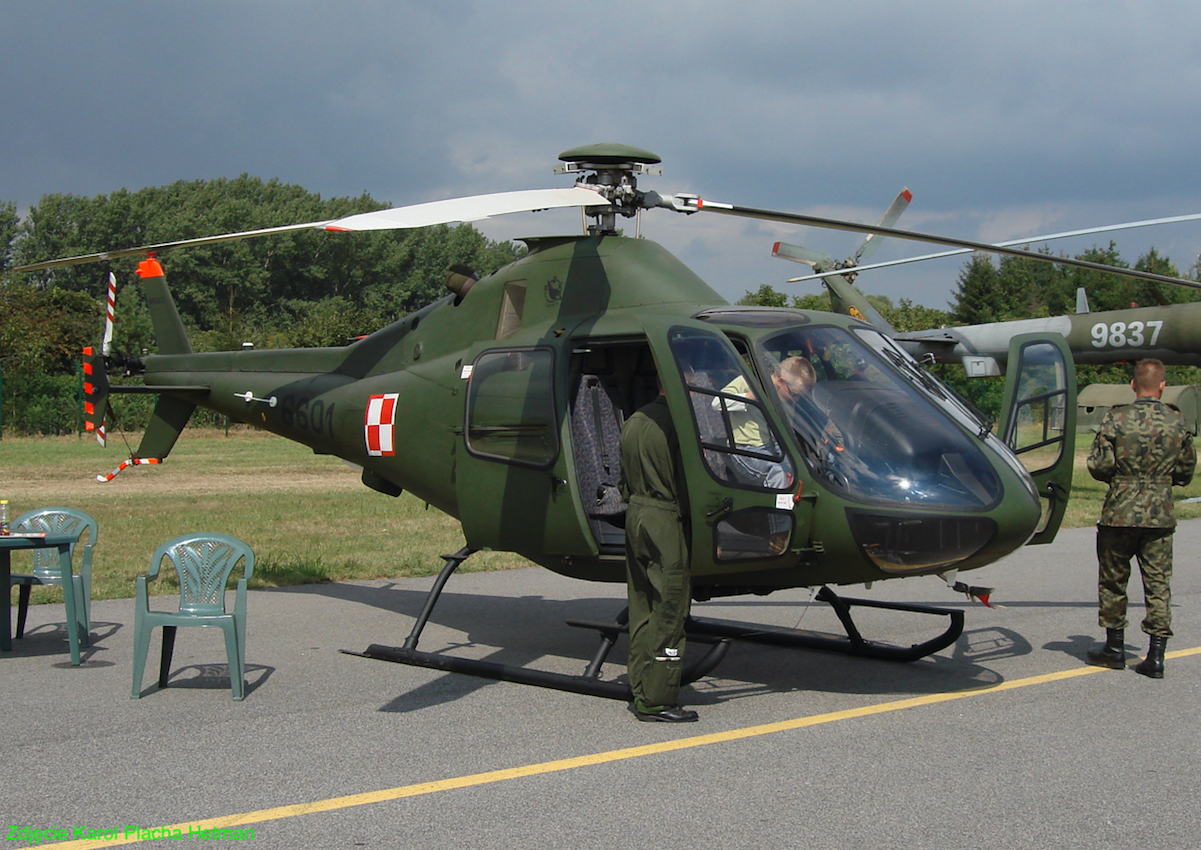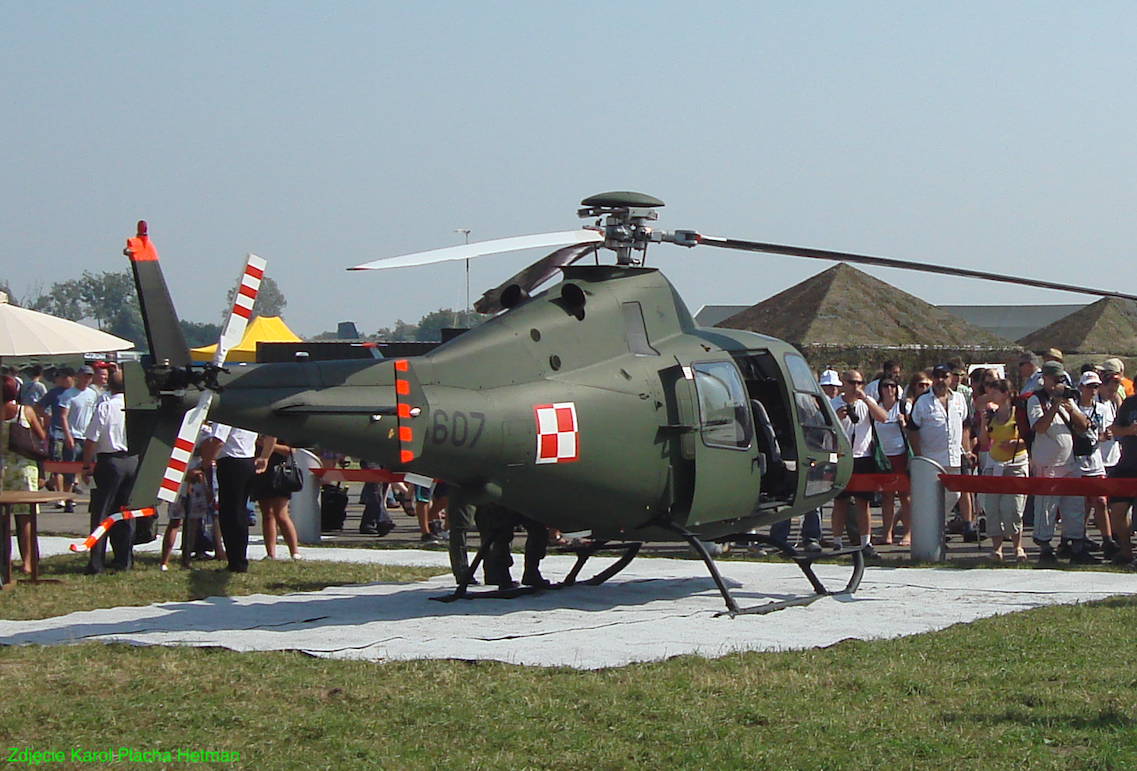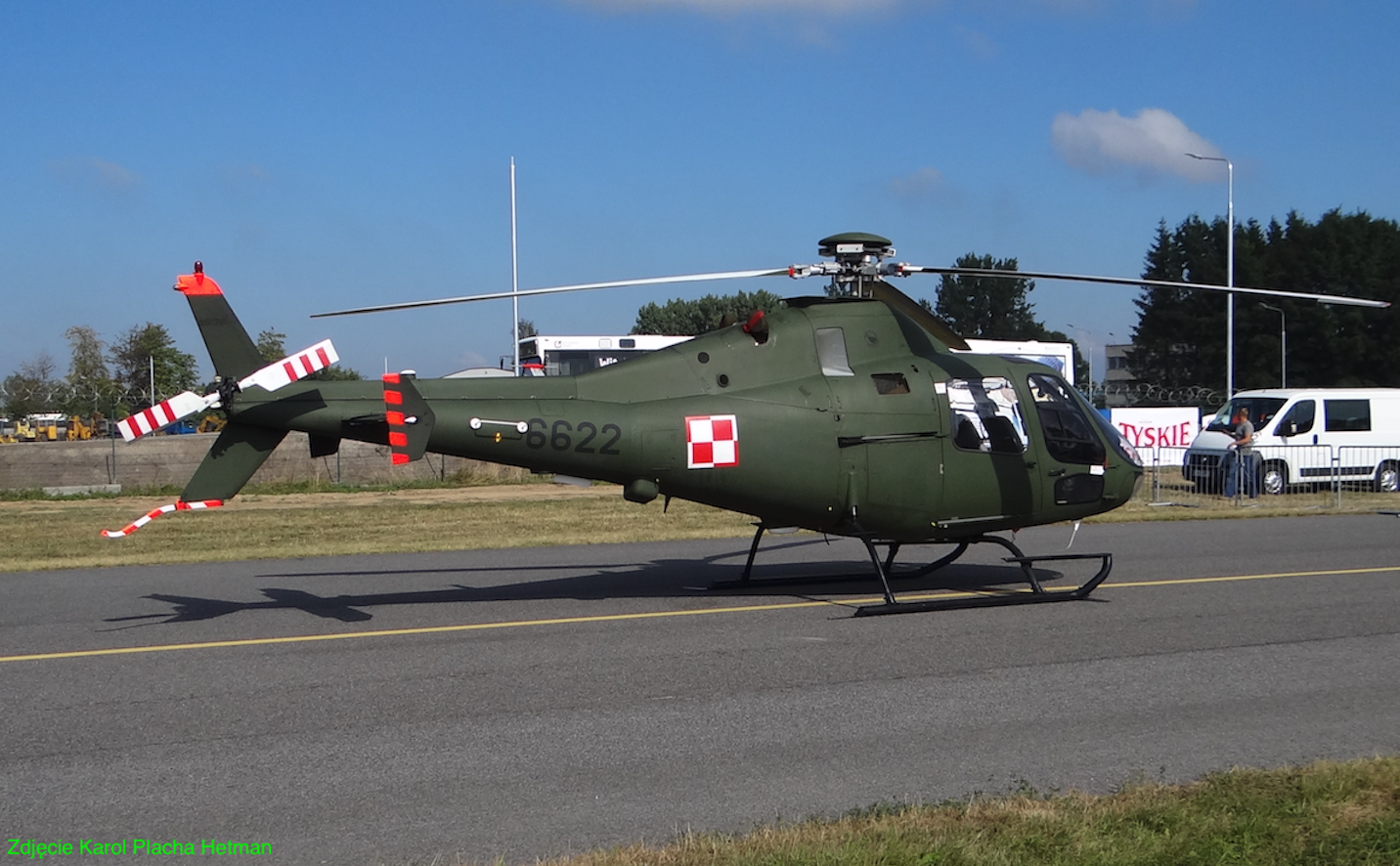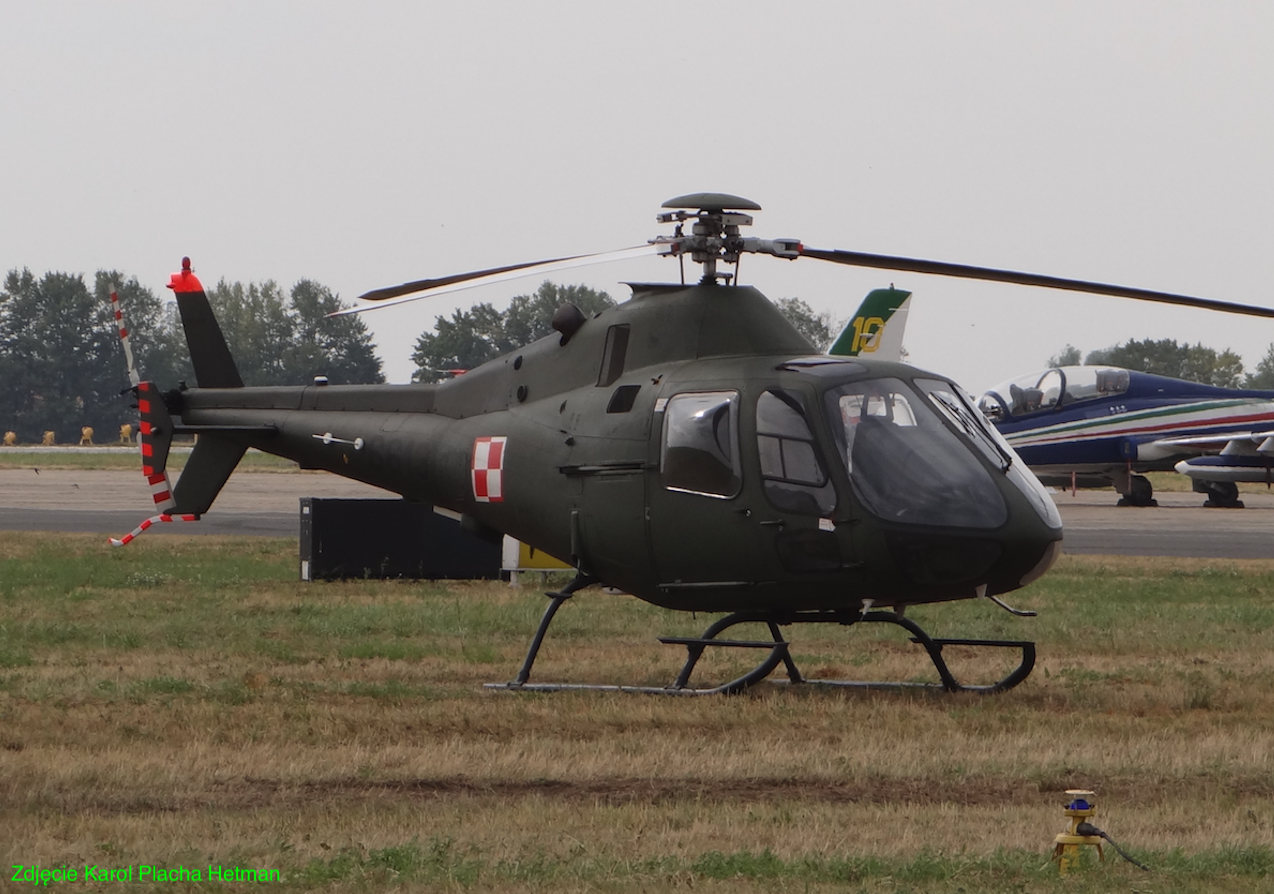Warszawa 2018-05-12
PZL Świdnik SW-4 Puszczyk.
290b Section 26.10.1996 year.
PZL Świdnik SW-4 Puszczyk is a Polish, light, modern, multi-role helicopter, built in a classic layout, which is powered by one turbine engine. The helicopter is used in the Polish Army and in civil aviation.




Construction development.
Design work on the light helicopter, which was eventually designated PZL SW-4, started at the beginning of the 1980s. The goal was to create a smaller helicopter than the PZL Mi-2, and above all, more economical. It is not true that the PZL SW-4 was to replace the PZL Mi-2 helicopter. However, it is true that the PZL SW-4 was a continuation of the 50-year-old idea of creating a light helicopter, implemented in the BŻ-4 Żuk and SM-4 Łątka programs.
For many reasons, work on the structure dragged on. However, the main reason was poor funding for the program and difficulties in accessing economical Western engines. The reason was also the simultaneous implementation of the program of a larger PZL W-3 Sokół helicopter, in which Muscovites were very interested.
The design team was headed by engineer Mr. Stanisław Trębacz. In order for the works to start at all, it was decided to use one PZL GTD-350 engine as a substitute drive. The same engine that was used in the PZL Mi-2 helicopter. Everyone knew that the engine was not very economical. However, this engine also had advantages. It was a low-failure construction, even reliable. Produced in Poland in WSK PZL Rzeszów, and the assembly line has long been depreciated.
In order for the helicopter to compete for orders from the Free World, it had to be built from the very beginning in accordance with the American FAR-27 and European JAR-27 regulations, or British regulations were taken into account. The helicopter was to meet the initial requirements of the Polish Army, Border Guard, Citizens' Militia and Sanitary Aviation.
The initial design was completed in 1986. In 1987, a full-size helicopter model was created. It was presented to the mock-up committee, composed of specialists from various aviation fields. Overall, the project was approved with some reservations. It was considered that the interior of the cabin is not very spacious, and the helicopter is too heavy for this class. Comments were also made on the drive unit. The Commission found that using the PZL GTD-350 engine, it would not be possible to replace it with a Western engine. This comment was not entirely justified, after all, the PZL Kania helicopter is a PZL Mi-2 with Western engines (an adapter was used). However, at that time, due to the prevailing communism, the PZL Świdnik plant was unable to quickly obtain the Western engine. As a result, work on the helicopter was suspended.
The SW-4 program was resumed in 1991, under the direction of engineer Krzysztof Bzówka. Due to the complete collapse of the market in the East, the design was verified so that the helicopter would only be adapted to the requirements of the West. First, the Western engine was immediately used. There was one more justification for this, in the form of the transformation of the Polish economy into Western technologies. An Allison 250-C20R engine was used.
Further changes were made to the design of the tail boom. The designers intended to use fenestron (enclosed fan) and even considered the NOTAR system (gas nozzle control; a system developed by McDonnell Douglas Helicopter Systems). Mainly for financial reasons, it was decided to stick with the classic tail rotor. Nevertheless, it was decided to enclose them with ballasts in such a way as to minimize the risk of accidentally getting a person into the rotating propeller.
According to the original recommendations, the passenger cabin was enlarged to accommodate 5 people. At the same time, the aerodynamic flow of the helicopter fuselage and tail boom was improved.
The work went very smoothly. The first SW-4 prototype received the number 600101. In December 1994, the SW-4 prototype was ready for trials. The tests began on January 12, 1995, and the test pilot was the test pilot, mgr inż. Zbigniew Dabski. Soon, the second prototype number 600102 joined the tests. In April 1996, the third prototype number 600103, registration SP-PZW, was added to the tests, which was intended for full flight tests.
The first flight of SW-4 No. 600103, SP-PZW made on October 26, 1996. The crew consisted of: pilot Zbigniew Dąbski, Artur Wasilak and Aleksander Czerwiński. The official flight for invited guests and representatives of companies involved in the program took place on October 29, 1996. In 1997, the prototype was presented at the Le Bourget Parisian air show. The helicopter attracted moderate interest and no contract was concluded. The reason was simple - you don't buy a machine that is not operated in the manufacturer's country. In 1998, the fourth prototype SW-4 No. 600104 was completed, registration SP-PSZ. Its first flight took place on October 19, 1998.
During this time, there was another slowdown in the program. The tests proceeded very slowly due to poor funding. To make matters worse, orders from potential users in Poland were not arriving. The process of collapsing the Republic of Poland was in progress. Although the program was not officially suspended, it was in fact frozen.
In the period 1998-2000, much was said and little was done. The Polish Army planned to purchase a small batch of SW-4 helicopters in training and liaison versions. But the need for a light helicopter for reconnaissance and anti-tank tasks was also signaled, to replace the worn-out PZL Mi-2 helicopters. PZL WSK Świdnik, on its own initiative, decided to develop a demonstrator of such versions. The constructors, having a lifting capacity of 440 kg, developed several versions for the Polish Army with equipment and armament mounted on booms on the sides of the hull: reconnaissance and observation, anti-tank and patrol and intervention variants.
In 2000, the Polish Army finally became interested in the training and liaison version of the SW-4 helicopter and the program was launched under the code name "Pogoria". The goal was to develop a helicopter specifically for the military. In 2003, a contract was concluded for the purchase of 30 helicopters for the 1st Aviation Training Center of the WSOSP in Dęblin, with an option for a transport and liaison squadron. For financial reasons, the implementation of the contract stretched over time.
On November 9, 2004, for the Polish Army, in Świdnik, the first serial copy of the SW-4 Puszczyk board number 0201, serial number. 660201. On November 15, 2004, this helicopter was presented in Dęblin. The acceptance tests lasted until January 2006. Officially, the first two SW-4 Nb 0201 and 0203 machines were handed over to the Air Force in Dęblin on November 16, 2006. After the ceremony, the Director of the Supply Department of the Polish Armed Forces, Brig. Roman Polak and the president of PZL Świdnik, Mr. Mieczysław Majewski, signed a contract for the delivery of another 22 machines. All in the school variant and all for Dęblin.
Unexpectedly, in November 2010, the Moscow state expressed interest in the helicopter, which declared its willingness to use it in a frosty climate. Therefore, the SW-4 had to undergo tests at low temperatures. Many employees of PZL WSK Świdnik recalled the many weeks of tests of the PZL W-3 Sokół helicopter in extremely low temperatures, in various regions of inhuman land, which Polish helicopters endured perfectly, and the Muscovites did not buy it anyway. What was there to do. The SW-4 helicopter was first tested in the climatic chamber of the Cracow University of Technology at temperatures down to -40 degrees Celsius. Then, in January 2011, in Far Siberia in Yakutsk on the Lena River. There were temperatures down to -50 degrees Celsius. The SW-4 has also passed high-temperature tests, which were conducted in the USA.
The SW-4 helicopter has been designed in accordance with the American aviation regulations FAR-27 and their European equivalent JAR-27. On November 14, 2002, the civil variant of the SW-4 helicopter received a type certificate from the Polish Civil Aviation Authority. On July 29, 2005, the machine was certified by the Russian MAK. On September 27, 2007, the PZL SW-4 helicopter received the EDAS certificate. In 2010, the SW-4 helicopter received the EASA certificate for the use of external suspension. The obtained certificate enabled the installation of external suspension and, for example, the use of the Bambi model 1012 tank manufactured by SEI in the fire-fighting version. On December 30, 2008, the SW-4 was certified by the Chinese Civil Aviation Authority. In May 2006, SW-4 was presented at the ILA'2006 air show.
Polish army.
The first SW-4 helicopters officially entered the equipment of the Polish Air Force in 2006. Deliveries of subsequent machines lasted until March 31, 2010 and finally 24 helicopters were delivered to the Polish Air Force. The Air Force uses SW-4 Puszczyk in a training variant, with doubled controls and extensive pilot equipment, adapted to perform NVG / IFR flights. At the Air Force Academy, the SW-4 was supplemented by the PZL Mi-2 helicopters as a training machine. Compared to them, the SW-4 has economical fuel consumption, causes less trouble in operation, and also takes half the time to prepare it for the next flight. In addition, it does not require ladders and platforms to operate. The only necessary equipment is a system of wheels for taxiing the helicopter on the parking plane and in the hangar, because the helicopter has a skid landing gear.
In 2012, the SW-4 helicopter simulator by ETC-PZL Aerospace Industries was delivered to the WSO SP in Dęblin. It consists of a cockpit and a spherical screen, which presents the image of the environment displayed from eight projectors.
Sale of PZL WSK Świdnik plants.
When discussing the SW-4 helicopter, it is impossible to refer to the political and economic background. Since 2008, the Masonic-Liberal Government of the Republic of Poland has sought to privatize all enterprises in Poland. PZL WSK Świdnik was also affected by this trend, as its majority shareholding was put up for sale. On July 31, 2009, two foreign companies; The Italian-British company AgustaWestland and the Czech company Aero Vodochody submitted price offers to the Industrial Development Agency for the purchase of 87.6% of shares in PZL-Świdnik. AgustaWestland was selected. On January 29, 2010, Agencja Rozwoju Przemysłu S.A. signed an agreement with an Italian-British manufacturer of helicopters for the sale of 87.62% of shares in Wytwórnia Sprzętu Komunikacji PZL-Świdnik S.A. The value of the transaction amounted to PLN 339 million.
PZL Świdnik is one of the most technologically advanced companies in Poland and, what is important, it produces high-tech final products. Over the years of operation, the company has produced several thousand rotorcraft, which puts it at the forefront in this respect. It is true that PZL Świdnik products are inferior to world-class products, but they have a good cost-effect ratio, i.e. they are price-competitive.
Placing appropriate funds for research and development could make Świdnik's leading products match, and certainly come close to, the world's best. PZL Świdnik is today (2018) one of the three (next to Eurocopter - Airbus Helicopters and AgustaWestland) companies in the EU (European Union) that can build a good helicopter. It is also a valued cooperator performing work for dozens of well-known aviation companies, such as Augusta-Westland, Bell, Cessna, Dassault, Boeing. The global aviation industry brings together advanced technologies. Companies like; Boeing, Airbus, Dassault; invest large funds in technologies and prototype constructions. The governments of the countries where these companies operate make no secret of the fact that they support them. Because if the company collapses, thousands of employees will go to the streets, and in the next elections the rulers will fall from their seats. As a result, PZL Świdnik was sold for just over PLN 300 million (the cost of one AW-101 helicopter produced by the new owner AgustaWestland).
The Polish public had the impression that the sale took place just before the announcement of the competition for a multi-role helicopter for the Polish Army. As a result, plans for a long-term modernization of the PZL W-3 Sokół helicopter fell through. This program was carried out with PZL Świdnik's own funds, with the completely passive attitude of the Masonic-liberal government of Donald Tusk, in every issue; grants for technical research, export and marketing support.
In 2016, ownership transformations took place in the Finmeccanica Helicopter concern and the plant in Świdnik became part of the Leonardo concern.
Written by Karol Placha Hetman
